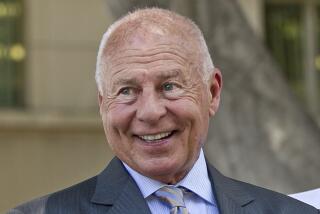Financier Found Guilty of Illegal Insider Trading : Tome Ordered to Give Up $3.5-Million Profit From Seagram Takeover Attempt
- Share via
NEW YORK — A federal judge Tuesday found an Italian financier who insinuated himself into the confidence of Seagram Co. Chairman Edgar M. Bronfman guilty of “callously” using that relationship to make illegal profits of $3.5 million in a 1981 securities trade.
It was the fourth legal development in a month on the insider-trading front.
U.S. District Judge Milton Pollack’s order that Giuseppe B. Tome, a former head of the overseas operations of Bache & Co. (now Prudential-Bache Securities) and E. F. Hutton, give up, or “disgorge,” the money is the largest disgorgement ordered by a judge in Securities and Exchange Commission history. One larger settlement, of $7.8 million, was negotiated by the SEC out of court earlier this year with traders in stock of Santa Fe International.
Pollack also held two defendants who received tips from Tome liable for $1.4 million in profits made by their brokerage customers. The $4.9-million total represents profits from the millions of dollars in purchases that Tome and several associates made in stock and options of St. Joe Minerals Corp., the target of a Seagram takeover attempt in 1981.
Pollack’s ruling takes its place with a string of SEC actions during the last month that have made the agency’s campaign against insider trading the talk of Wall Street.
Since early May, the agency has settled a $400,000 case against the investment firm of First Boston; sued Dennis B. Levine, a prominent mergers specialist with the Drexel Burnham Lambert investment banking firm, for making $12.6 million in illicit profits, and provided evidence used by a federal grand jury to indict five young New York professionals with passing around confidential merger information.
Indicted in 1984
Pollack’s order, issued after a non-jury trial that ended months ago, is still subject to appeal. Tome, who was indicted in 1984 in connection with the case, left the United States abruptly in April, 1981, soon after the SEC began its investigation of his trading, and he has not returned.
Pollack’s order, however, is partially secured by more than $2 million and millions of dollars in stock held in frozen accounts here and abroad by Banca della Svizzera Italiana, through which Tome conducted his trades.
Tome’s personal lawyer could not be reached Tuesday. Bruno Schachner, an attorney for three Tome firms also named as defendants by the SEC, said he is “disappointed in the decision” but added that “I do not think it is appropriate to take public issue with a . . . decision of a judge.”
At the core of Tome’s trading, Pollack found, was an acquaintance with Bronfman “that flowered and bloomed into an intimate friendship and a professional association . . . of which he callously took shoddy and unlawful advantage.”
A spokesman for Bronfman said the executive would not talk about his relationship with Tome.
“He hasn’t said anything about it, nor does he care to,” said the spokesman, Robert Kasmire. In court testimony, Bronfman said he incautiously discussed Seagram’s secrets with the Italian broker because after Tome’s “20 years in this business . . . he ought to know the rules. I assume he does know the rules.”
According to testimony in the case, Tome and Bronfman met in July, 1980. Bronfman was impressed with Tome’s financial acumen and within weeks had made him an unofficial adviser to Seagram, a major producer and marketer of spirits and wine, on foreign currency matters.
The two men also struck up a close personal friendship, and Bronfman opened a commodities account at Tome’s Geneva brokerage. The pair invested together in “Sophisticated Ladies,” the Broadway show, and at one point Bronfman even covered a bounced check that Tome had issued to the show’s producers. The families vacationed together in Switzerland and the hunt country of Virginia.
Throughout this time, Bronfman was telling Tome of Seagram’s secret plans for major corporate acquisitions. Pollack’s order indicated that Tome used inside information to trade in stock and options of Texaco and Santa Fe, two tentative Seagram targets. (Those trades were not cited in the SEC lawsuit, however.) In some cases, testimony showed, Tome learned from Bronfman of Seagram’s plans even before its board of directors.
On March 9, 1981, Bronfman declined a dinner invitation from Tome, saying he had to visit Montreal for a board meeting. Tome concluded that a Seagram offer was imminent for St. Joe, which he knew as Bronfman’s next target.
“The extraordinary scope of (Tome’s) financial activities on the next morning was beyond any notion of rational, normal trading,” Pollack found.
Tome placed orders for thousands of options on St. Joe and made at least 14 phone calls to associates and clients urging and ordering them to place more orders.
Tome-related purchases accounted for as much as 74% of the trading volume of some of those options that day and nearly 11% of the volume of St. Joe stock on the New York Stock Exchange. The price of St. Joe stock rose 50%.
Seagram was ultimately outbid for St. Joe by Irvine-based Fluor Corp.
Tome never revealed his trading to Bronfman. But after the SEC disclosed that it was investigating trading in St. Joe through a Swiss bank, Bronfman suspected Tome. In several subsequent meetings, the judge’s order said, Tome lied about having conducted the trading.
More to Read
Inside the business of entertainment
The Wide Shot brings you news, analysis and insights on everything from streaming wars to production — and what it all means for the future.
You may occasionally receive promotional content from the Los Angeles Times.










